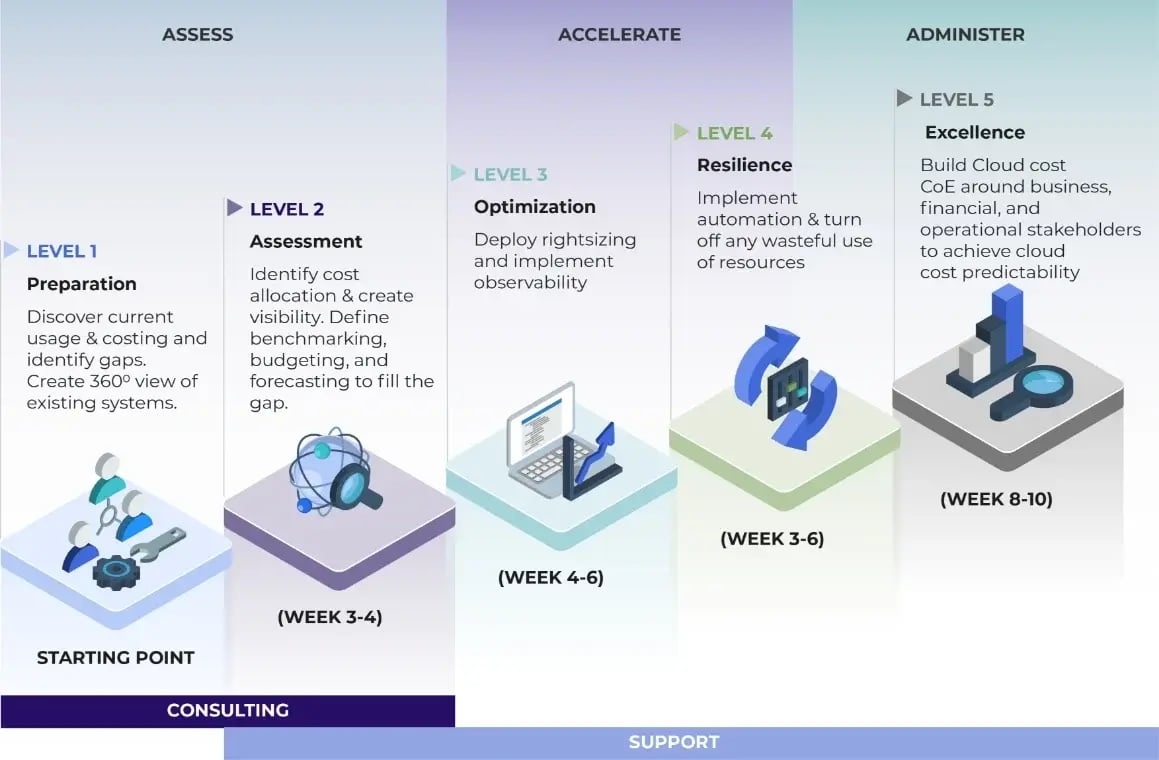In the fast evolving technological landscape, businesses are increasingly relying on cloud-based solutions to streamline their operations and drive innovation. However, the growing reliance on cloud infrastructure has led to a surge in cloud spending, making cloud financial management a pressing concern for many organizations. According to a recent survey by Nutanix, over 34% of respondents identified cloud cost management as a significant challenge.
To reign in their cloud spending yet optimize cloud operations, companies are adopting a new approach to cloud cost management known as Financial Operations (FinOps).
FinOps (Cloud Financial Operations) is an operational model that blends technology, business, and finance to manage and optimise cloud spending. The FinOps Foundation defines it as a cultural shift that brings together cross-functional teams to ensure that cloud operations align with financial goals. By fostering communication and collaboration between IT and financial teams, Cloud FinOps enables organizations to strike a balance between innovation and cost management.
And when you blend Site Reliability Engineering (SRE) and FinOps, the company performance reaches new peaks. The benefits?
- Considerably minimize system outages and downtime
- Foster reliability and service quality
- Offer an enhanced end-user experience
- Ensure solid cloud ROI through cloud cost accountability
Developed and popularized by Google, SRE is a band of software tools and services that ensure reliability and availability of IT infrastructure round the clock, reduce downtiming and system outages, and implement automation to minimize toil. An SRE engineer is well equipped in using automation tools that help monitor and observe site reliability.
The fusion of SRE+FinOps is a relatively new concept and successful implementation of the discipline for cloud management requires a well-defined roadmap, clearly laid out strategies and proper execution of the same. This article delves into the concept of SRE+FinOps and outlines a roadmap for seamless implementation of this novel discipline as a healthy business practice.
Implementing SRE+FinOps in Your Organization: The Road Map
The process of implementing SRE+FinOps involves several key stages, each contributing to the overall success of the initiative. Let us dig deep into how an organization can effectively adopt FinOps to optimize cloud spending and maximize business value.

Stage 1- Assess
Evaluating the present cloud usage and costing is a significant step before implementing SRE+FinOps. The organizational assessment will help understand their present cloud expenses, locate cost optimization opportunities, and sync in their cloud spending with business objectives. The stage can be further categorized into two levels:
Level 1: Preparation
Start with gathering comprehensive data on your enterprise’s cloud usage like information on virtual machines, storage, networking, databases, etc. Evaluate historical cost data to capture spending patterns and trends. Try to identify any considerable spikes in expenditure or recurring wastefulness that requires attention.
Level 2: Assessment
Start by benchmarking the organization’s cloud costs against industry standards and best practices. Recognize potential areas for optimizing cloud spending. Also, identify places where improvement is required and set targets for cost predictability. Use the gathered data to build a budget and plan upcoming cloud spending. Make sure that all cloud resources are properly tagged and categorized. This helps in optimal cost allocation among teams.
Stage 2 – Accelerate
By fusing automation, cost monitoring, resource optimization, proactive incident management, etc, companies can accelerate the implementation of SRE+FinOps. This is often achieved by rightsizing resources, leveraging Reserved Instances or Savings Plans, etc. This not only helps in significantly reducing cloud wastage, but also enhances reliability and performance of cloud-based operations. The key is to foster a culture of collaboration, accountability, and perpetual improvement within the organization.
Level 3: Optimization
Optimization in the process of SRE+FinOps adoption can be achieved through rightsizing and observability. Let’s evaluate the two key practices:
- Rightsizing
Rightsizing is the practice of optimizing cloud resources with the actual workload. This aims at eliminating overprovisioned resources, thereby avoiding wasteful costs. However, it ensures that performance and reliability are not compromised, at the same time. Rightsizing is a crucial step at this level as it helps zero in on the suitable resources for your workloads. Utilize automation to assess resource usage and automatically adjust services to align with actual demand.
- Implementing Observability
Observability ensures that organizations are a step ahead in identifying any potential system outages before they escalate. This helps attend major system health issues right on time, resulting in maintaining high reliability and enhanced end-user experience. Observability can also help optimize cost by offering insights into resource utilization, contributing in rightsizing. This also helps identify areas of potential cloud waste.
Level 4: Resilience
Accelerate the implementation of SRE+FinOps through automation and reducing wasteful use of resources. This requires a well-defined strategy and a proactive approach within the organization. Implementing automation to monitor cloud costs allows the organization to have real-time visibility into the spending. This, in turn, helps identify potential areas of wasteful spending. Also, this notifies the relevant stakeholders whenever the cloud spending reaches the predefined (budgeted) limit and brings down unproductive or inefficient cloud spending.
Stage 3 – Administer
This stage is crucial in keeping the momentum going. It refers to the continuous efforts adopted by the organization towards cloud cost optimization and offering reliability at the same time. In this stage, the organization focuses on maintaining and improving the implementation of SRE+FinOps. The stage comprises “Resilience” and “Excellence”. Let us see what is to be done in these stages.
Level 5: Excellence
By setting up a Cloud Cost CoE and involving business, financial, and operational stakeholders, organizations can predict cloud costs. This kind of alliance ensures that cost management efforts match with business objectives, and cloud expenses are aligned effectively while adding to the business’s growth and innovation. It’s an effort towards fostering cost awareness and accountability among various teams in the organization, helping cultivate cost-conscious decisions when it comes to managing cloud resources.
Here’s a a step-by-step guide to establishing a Cloud Cost CoE:
- Select key stakeholders from finance, operations, development, and product owners. These stakeholders will play definitive roles in bringing to life the CoE strategy.
- Define clear objectives for the Cloud Cost CoE. These must run parallel to the company’s holistic business goals and may include cost optimization, cost predictability, resource utilization improvement, and continuous cost monitoring.
- Create a governance model that takes into account the CoE’s structure, roles, and responsibilities. Develop decision-making processes and make sure the CoE has the authority to implement and enforce cost management policies.
- Allocate key resources to the CoE—like budget, tools, and personnel. Dedicate resources that the CoE can effectively implement its initiatives.
Setting up regular meetings and reviews with stakeholders is crucial in order to discuss progress, roadblocks, and opportunities. This also aids in aligning actions with business objectives.
Conclusion
As highlighted by 2023 State of the Cloud Report, 82% of the organizations find managing the cloud spend as the top cloud challenge. SRE+FinOps emerges as a vital solution, merging the prowess of SRE and financial teams to help businesses navigate this challenge. This blend empowers businesses to strike the right balance between innovation and cost control, unlocking efficiency and maximizing savings. By adopting the SRE+FinOps roadmap, organizations can pave the way for sustainable growth and success, truly harnessing the power of the cloud. Ready to unlock your cloud potential? Engage with us today.
Need help implementing FinOps in your organization? Reach out to our team of experts today!
Our Services
Customer Experience Management
- Content Management
- Marketing Automation
- Mobile Application Development
- Drupal Support and Maintanence
Enterprise Modernization, Platforms & Cloud
- Modernization Strategy
- API Management & Developer Portals
- Hybrid Cloud & Cloud Native Platforms
- Site Reliability Engineering




